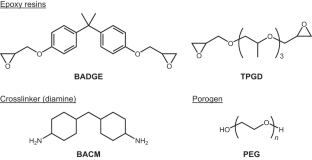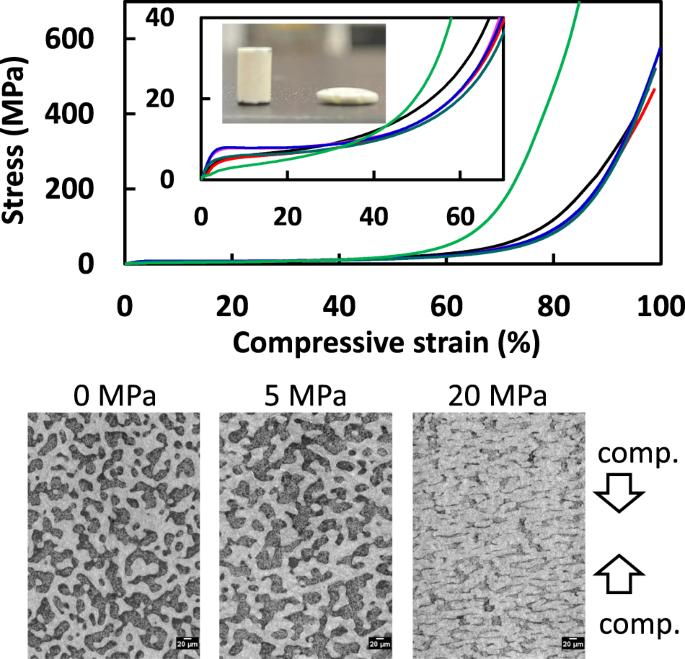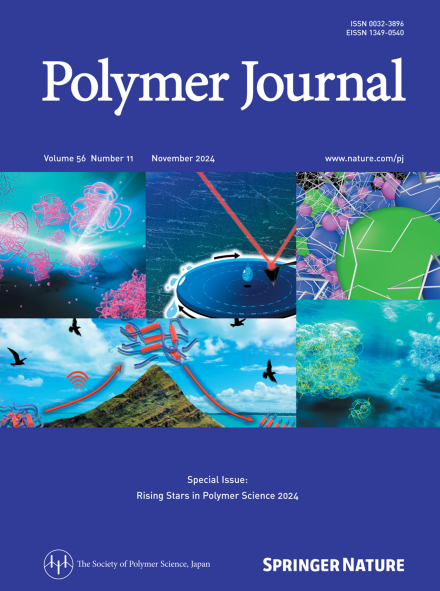Study on the deformation and fracture of epoxy monoliths through mechanical tensile and compressive tests and X-ray CT imaging
IF 2.3
4区 化学
Q3 POLYMER SCIENCE
引用次数: 0
Abstract
As porous polymer materials with continuous epoxy skeletons and pores, epoxy monoliths are used as column fillers in HPLC, separators in lithium-ion batteries, and precursor polymers for monolith adhesion and co-continuous network polymer fabrication. Due to their unique mechanical properties and fracture behavior, epoxy monoliths can incur large deformation and are different from the bulk thermoset of epoxy resins that exhibit hard and brittle features. In this study, we prepared an epoxy monolith using 2,2’-bis(4’-glycidyloxaphenyl)propane (BADGE) and tripropylene glycol diglycidyl ether (TPGD) as epoxy resins, 4,4’-methylenebis(cyclohexylamine) (BACM) as a crosslinker, and poly(ethylene glycol) (PEG) as a porogen, and TPGD-induced effects on the pore structure and properties of the obtained monoliths were investigated. To clarify the relationship between the pore structure and the mechanical properties of the monolith, scanning electron microscopy (SEM) observations and tensile and compression tests were performed. In addition, X-ray CT imaging nondestructively revealed a change in the inner porous structure of the monolith after a large deformation occurred under various compression conditions. We clarified the effects of the TPGD addition on the monolith structure and the mechanical properties with tensile and compressive deformation. As porous polymer materials with continuous epoxy skeletons and pores, epoxy monoliths exhibit unique mechanical properties and fracture behavior different from the bulk thermoset of epoxy resins. In this article, we describe the thermal properties, pore structures, and mechanical properties of epoxy resins with tensile and compressive deformation of the monoliths. In addition, a change in the inner porous structure after large deformation was nondestructively observed by X-ray CT imaging.


通过机械拉伸和压缩试验以及 X 射线 CT 成像研究环氧树脂单体的变形和断裂情况
作为具有连续环氧骨架和孔隙的多孔聚合物材料,环氧单体可用作高效液相色谱中的柱填料、锂离子电池中的分离剂,以及用于单体粘合和共连续网络聚合物制造的前体聚合物。环氧单体具有独特的机械性能和断裂行为,可产生较大的变形,不同于表现出硬脆特征的环氧树脂块体热固性。在这项研究中,我们使用 2,2'-双(4'-缩水甘油氧苯基)丙烷(BADGE)和三丙二醇二缩水甘油醚(TPGD)作为环氧树脂,4、以 4,4'-亚甲基双(环己基胺)(BACM)为交联剂,聚乙二醇(PEG)为成孔剂,研究了 TPGD 诱导对所得单片孔结构和性能的影响。为明确孔隙结构与单片石机械性能之间的关系,进行了扫描电子显微镜(SEM)观察以及拉伸和压缩试验。此外,X 射线 CT 成像非破坏性地揭示了在各种压缩条件下发生大变形后整体石材内部多孔结构的变化。我们明确了添加 TPGD 对整体结构的影响,以及拉伸和压缩变形对机械性能的影响。
本文章由计算机程序翻译,如有差异,请以英文原文为准。
求助全文
约1分钟内获得全文
求助全文
来源期刊

Polymer Journal
化学-高分子科学
CiteScore
5.60
自引率
7.10%
发文量
131
审稿时长
2.5 months
期刊介绍:
Polymer Journal promotes research from all aspects of polymer science from anywhere in the world and aims to provide an integrated platform for scientific communication that assists the advancement of polymer science and related fields. The journal publishes Original Articles, Notes, Short Communications and Reviews.
Subject areas and topics of particular interest within the journal''s scope include, but are not limited to, those listed below:
Polymer synthesis and reactions
Polymer structures
Physical properties of polymers
Polymer surface and interfaces
Functional polymers
Supramolecular polymers
Self-assembled materials
Biopolymers and bio-related polymer materials
Polymer engineering.
 求助内容:
求助内容: 应助结果提醒方式:
应助结果提醒方式:


